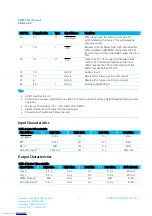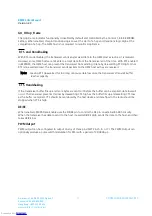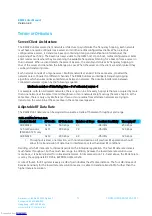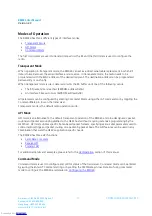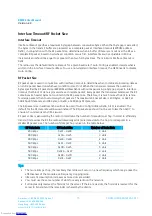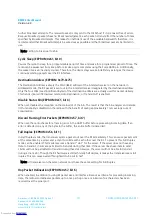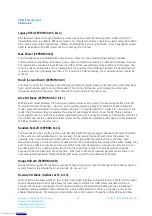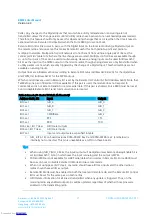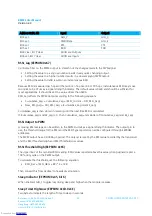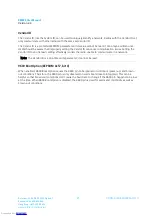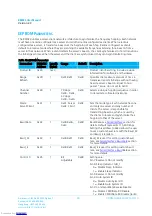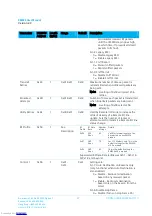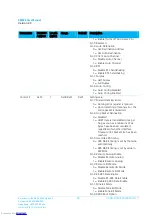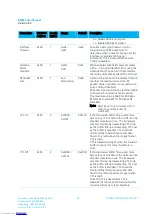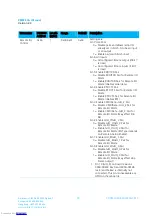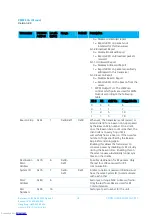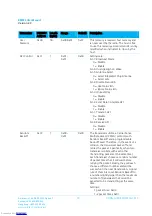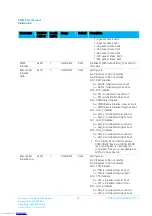
RM024 User Manual
Version 2.3
Americas: +1-800-492-2320 Option 2
Europe: +44-1628-858-940
Hong Kong: +852-2923-0610
www.lairdtech.com/wireless
19
CONN-GUIDE-RAMP24-0413
further broadcast attempts. The received packet is only sent to the OEM host if it is received free of errors.
Because broadcast packets have no RF acknowledgement, each packet is transmitted the number of times
specified by Broadcast Attempts. This makes for inefficient use of the available bandwidth; therefore, it is
recommended that Broadcast Attempts be set as low as possible and that broadcast packets be limited in
use.
Note: Setting to 0 is equal to 256.
Cyclic Sleep (EEPROM 0x61, bit 0)
Causes the radio to sleep for a programmable period of time and wake for a programmer period of time. The
radio can be awakened from sleep before its sleep cycle completes using the Force 9600 pin. Additionally,
the wake time is an inactivity counter. Therefore, the device stays awake indefinitely as long as the device
continues sending packets over the RF interface.
Destination Address (EEPROM 0x79-0x75)
The Destination Address is simply the MAC (IEEE) address of the intended receiver on the network. In
Addressed mode, the RF packet is sent out to the intended receiver designated by the destination address.
Only the four LSBs (Least Significant Bytes) of the destination address are actually used for packet delivery.
This field is ignored if Broadcast mode, Auto Destination, or Transmit API is enabled.
Disable Status Bin (EEPROM 0xC1, bit 4)
When set, disables the reception on the status slot of the bin. The result is that the bin analyzer and remote
I/O functionality is disabled on the radio with the benefit of saving approximately 1 mA average current
consumption.
Discard Framing Error Packets (EEPROM 0x57, bit 7)
When set, the radio checks for a framing error in the UART buffer before processing incoming data. If an
error is detected on any of the bytes in the buffer, the entire buffer is discarded.
Full Duplex (EEPROM 0x56, bit 1)
In Half Duplex mode, the transceiver sends a packet out over the RF immediately. This can cause packets sent
at the same time by a server and a client to collide with each other over the RF. To prevent this, Full Duplex
mode can be enabled. This mode reserves a transmit “slot” for the server. If the server does not have any
data to transmit, clients are permitted to transmit during that time. If the server does have data to send,
clients will not be permitted to transmit during that slot. Likewise, the server will not be able to transmit
during a client slot. Though the RF hardware is still technically half duplex, it makes the transceiver seem full
duplex. This can cause overall throughputs to be cut in half.
Note: All transceivers on the same network must have the same setting for Full Duplex.
Hop Packet Delineation (EEPROM 0x57, bit 6)
When enabled, in addition to using RF packet size and interface timeout as criteria for processing incoming
data, the radio also delineates packets up to once per hop once a minimum of six characters has been
received over the serial port.
Downloaded from
Downloaded from
Downloaded from
Downloaded from
Downloaded from
Downloaded from
Downloaded from
Downloaded from
Downloaded from
Downloaded from
Downloaded from
Downloaded from
Downloaded from
Downloaded from
Downloaded from
Downloaded from
Downloaded from
Downloaded from
Downloaded from



